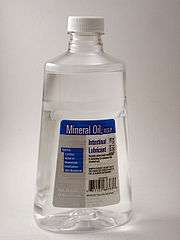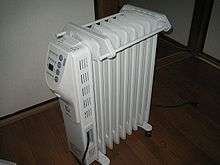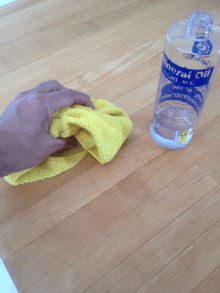Mineral oil
Mineral oil is any of various colorless, odorless, light mixtures of higher alkanes from a mineral source, particularly a distillate of petroleum,[1] as distinct from usually edible vegetable oils.

The name mineral oil by itself is imprecise, having been used for many specific oils over the past few centuries. Other names, similarly imprecise, include white oil, paraffin oil, liquid paraffin (a highly refined medical grade), paraffinum liquidum (Latin), and liquid petroleum. Baby oil is a perfumed mineral oil.
Most often, mineral oil is a liquid by-product of refining crude oil to make gasoline and other petroleum products. This type of mineral oil is a transparent, colorless oil, composed mainly of alkanes[2] and cycloalkanes, related to petroleum jelly. It has a density of around 0.8–0.87 g/cm3.[3]
Nomenclature
Some of the imprecision in the definition of the names (e.g., "mineral oil", "white oil") reflects usage by buyers and sellers who did not know, and usually did not need to care about, the precise chemical makeup. Merriam-Webster states the first use of the term “mineral oil” was 1771.[4] Prior to the late 19th century, the chemical science to determine such makeup was unavailable in any case. A similar lexical situation occurred with the term "white metal".
"Mineral oil", sold widely and cheaply in the US, is not sold as such in Britain. Instead British pharmacologists use the terms "paraffinum perliquidum" for light mineral oil and "paraffinum liquidum" or "paraffinum subliquidum" for somewhat thicker (more viscous) varieties. The term "paraffinum liquidum" is often seen on the ingredient lists of baby oil and cosmetics. British aromatherapists commonly use the term "white mineral oil". In lubricating oils, mineral oil is termed from groups 1 to 2 worldwide and group 3 in certain regions. This is because the high end of group 3 mineral lubricating oils are so pure that they exhibit properties similar to polyalphaolefin – PAO oils (group 4 synthetics).[5]
Toxicology
The World Health Organization classifies untreated or mildly treated mineral oils as group 1 carcinogens to humans; highly refined oils are classified as group 3, meaning that they are not suspected to be carcinogenic, but available information is not sufficient to classify them as harmless.[6]
The UK Food Standards Agency (FSA) carried out a risk assessment on the findings of a survey made in 2011 on risks due to migration of components from printing inks used on carton-board packaging, including mineral oils, into food. The FSA did not identify any specific food safety concerns due to inks.[7]
People can be exposed to mineral oil mist in the workplace by breathing it in, skin contact, or eye contact. In the United States, the Occupational Safety and Health Administration has set the legal limit for mineral oil mist exposure in the workplace as 5 mg/m3 over an 8-hour workday, the National Institute for Occupational Safety and Health has set a recommended exposure limit of 5 mg/m3 over an 8-hour workday, and 10 mg/m3 short-term exposure has been rescinded according to the 2019 Guide to Occupational Exposure Values compiled by the ACGIH. Levels of 2500 mg/m3 and higher are indicated as immediately dangerous to life and health. However, current toxicological data does not contain any evidence of irreversible health effects due to short-term exposure at any level; the current value of 2500 mg/m3 is indicated as being arbitrary.[8]
Comestics containing mineral oil shouldn't be used for lip care because of their toxicity.[9]
Applications
Biomedicine
Laxative
Mineral oil is used as a laxative to alleviate constipation by retaining water in stool and the intestines.[10] Although generally considered safe, as noted above, there is a concern of mist inhalation leading to serious health conditions such as pneumonia.[11]
Mineral oil can be administered either orally[12] or as an enema.[13]Also, it is sometimes used as a lubricant in enema preparations, because most of the ingested material is excreted in the stool rather than being absorbed by the body.[14]
Cell culture
Mineral oil of special purity is often used as an overlay covering microdrops of culture medium in petri dishes, during the culture of oocytes and embryos in IVF and related procedures. The use of oil presents several advantages over the open culture system: it allows for several oocytes and embryos to be cultured simultaneously, but observed separately, in the same dish; it minimizes concentration and pH changes by preventing evaporation of the medium; it allows for a significant reduction of the medium volume used (as few as 20 microlitres per oocyte instead of several millilitres for the batch culture); and it serves as a temperature buffer minimizing thermal shock to the cells while the dish is taken out of the incubator for observation.
Veterinary
Over-the-counter veterinarian-use mineral oil is intended as a mild laxative for pets and livestock.[15] Certain mineral oils are used in livestock vaccines, as an adjuvant to stimulate a cell-mediated immune response to the vaccinating agent. In the poultry industry, plain mineral oil can also be swabbed onto the feet of chickens infected with scaly mites on the shank, toes, and webs. Mineral oil suffocates these tiny parasites.[16] In beekeeping, food grade mineral oil-saturated paper napkins placed in hives are used as a treatment for tracheal and other mites. It is also used along with a cotton swab to remove un-shed skin (ashes) on reptiles such as lizards and snakes.
Cosmetics
Mineral oil is a common ingredient in baby lotions, cold creams, ointments, and cosmetics. It is a lightweight inexpensive oil that is odorless and tasteless. It can be used on eyelashes to prevent brittleness and breaking and, in cold cream, is also used to remove creme make-up and temporary tattoos. One of the common concerns regarding the use of mineral oil is its presence on several lists of comedogenic substances. These lists of comedogenic substances were developed many years ago and are frequently quoted in the dermatological literature.
The type of highly refined and purified mineral oil found in cosmetic and skincare products is noncomedogenic (does not clog pores).[17]
Mechanical, electrical, and industrial

Mineral oil is used in a variety of industrial/mechanical capacities as a non-conductive coolant or thermal fluid in electric components as it does not conduct electricity and functions to displace air and water. Some examples are in transformers, where it is known as transformer oil,[18] and in high-voltage switchgear, where mineral oil is used as an insulator and as a coolant to disperse switching arcs.[19] The dielectric constant of mineral oil ranges from 2.3 at 50 °C (122 °F) to 2.1 at 200 °C (392 °F).[20]
Mineral oil is used as a lubricant, a cutting fluid, and a jute batching oil. Spindle oils are light mineral oils used as lubricants in textile industries. Electric space heaters sometimes use mineral oil as a heat transfer oil. Because it is noncompressible, mineral oil is used as a hydraulic fluid in hydraulic machinery and vehicles.
An often cited limitation of mineral oil is that it is poorly biodegradable; in some applications, vegetable oils such as cottonseed oil or rapeseed oil may be used instead.[21]
Food preparation
Food grade mineral oil has an E number of E905a, although it has not been approved in food products in the European Union, and incidental amounts in foods are carefully regulated.[22] Because of its properties that prevent water absorption, combined with its lack of flavor and odor, food grade mineral oil is a popular preservative for wooden cutting boards, salad bowls, and utensils. Rubbing a small amount of mineral oil into a wooden kitchen item periodically, will impede absorption of food liquids, and thereby food odors, and ease cleaning. By impeding water absorption, wetting and drying cycles, which can cause cracks or splits in wood, are reduced although some of the mineral oil is picked up by the food and ingested. Outside of the European Union, it is occasionally used in the food industry, particularly for confectionery. In this application, it is typically used for the glossy effect it produces, and to prevent the candy pieces from adhering to each other. It has been discouraged for use in children's foods,[23] though it is still found in many confectioneries, including Swedish Fish.[24] The use of food grade mineral oil is self-limiting because of its laxative effect. The maximum daily intake is calculated to be about 100 mg, of which some 80 mg are contributed from its use on machines in the baking industry.[14]
Other uses

Mineral oil's ubiquity has led to its use in some niche applications as well. It is used for treating and preserving wooden butcher block counter tops.[25] It is recommended by the American Society for Reproductive Medicine for use as a fertility-preserving vaginal lubrication.[26] However, it is known that oils degrade latex condoms.[27]
Mineral oil is commonly used to create a "wear" effect on new clay poker chips, which can otherwise be accomplished only through prolonged use.[28] Either the chips are placed in mineral oil for a short time, or the oil is applied to each chip then rubbed off. This removes any chalky residue left over from manufacture, and also improve the look and "feel" of the chips.
It is used as the principal fuel in some types of gel-type scented candles.[29]
It is used for cooling, for example liquid submersion cooling of components in some custom-built computers.[30][31] Veterinarian-grade mineral oil is inexpensive, and is frequently used by amateur radio operators as coolant in RF dummy loads, as mineral oil is typically used as the insulating and cooling fluid in large electrical equipment such as transformers, see more above.
Mineral oil is used as a brake fluid in some cars and bicycle disc brakes.
Mineral oil is burned in specialized “machines” (both manufactured and home-made) to produce a thick white smoke that is then blown into automotive evaporative emissions (EVAP) systems to find leaks.
It is used for polishing alabaster in stonework and lubricating and cleaning pocket knives or food handling tools that use an open bearing, thus needing periodic lubrication. Light mineral oil (paraffinum perliquidum) is used as a honing oil when sharpening edge tools (such as chisels) on abrasive oil stones. Mineral oil USP or light mineral oil can be used as an anti-rust agent for blades.
It is an inexpensive alternative for storing reactive metals (lithium, sodium, etc.).
Horticultural oil is often made of a combination of mineral oil and detergent. It is sprayed on plants to control scale, aphid, and other pest populations by suffocation.
It is used to overlay polymerase chain reactions in biotechnology to prevent loss of water during heating cycles. It is often used to suspend crystals for use in X-ray crystallography.
It is used as a transparent collision material for reactions in particle physics, as in the MiniBooNE neutrino oscillation experiment.[32]
As a relatively low heat combustible with no flavor or odor, mineral oil can be used in fire breathing and firedancing for entertainment,[33] but there is a risk of injury.[34][35]
Paraffin oil is commonly used to fill Galileo thermometers. Due to paraffin oil's freezing temp being lower than water (approx. 24 °F or −4 °C), this makes them less susceptible to freezing during shipment or when stored in a cold environment.[36]
See also
References
- Mineral oil (Dictionary.com) Archived 30 September 2015 at the Wayback Machine
- "Archived copy" (PDF). efsa.europa.eu. Archived from the original (PDF) on 3 June 2018. Retrieved 27 January 2007.CS1 maint: archived copy as title (link)
- "Mechanical properties of materials". Kaye and Laby Tables of Physical and Chemical Constants. National Physical Laboratory. Archived from the original on 11 March 2008. Retrieved 6 March 2008.
- "Definition of MINERAL OIL". www.merriam-webster.com. Retrieved 10 September 2018.
- "Archived copy". Archived from the original on 22 June 2018. Retrieved 14 August 2017.CS1 maint: archived copy as title (link)
- International Agency for Research on Cancer (17 June 2011). "Agents Classified by the IARC Monographs, Volumes 1–102" (PDF). Lyon, France: International Agency for Research on Cancer. pp. 3, 19. Archived (PDF) from the original on 25 October 2011. Retrieved 11 November 2011.
- "Survey of printing inks and mineral oils". Food Standards Agency. London. 15 December 2011. Archived from the original on 15 May 2012.
- "Oil mist (mineral). Immediately Dangerous to Life or Health Concentrations (IDLH)". www.cdc.gov. 4 December 2014. Retrieved 12 June 2018.
- Warentest, Stiftung. "Mineralöle in Kosmetika - Kritische Stoffe in Cremes, Lippenpflegeprodukten und Vaseline - Stiftung Warentest". www.test.de.
- "Drugs & Medications".
- Weinstein, M. (2001). "First do no harm: The dangers of mineral oil". Paediatrics & Child Health. 6 (3): 129–131. doi:10.1093/pch/6.3.129. PMC 2804525. PMID 20084222.
- "Mineral Oil". Drugs & Medications. WebMD. Retrieved 20 April 2019.
- "Mineral Oil rectal enema". Health Library / Drugs, Devices & Supplements. Cleveland Clinic. Retrieved 20 April 2019.
- WHO Food Additive Monograph 70.39 Archived 6 August 2007 at the Wayback Machine, retrieved 20 Sep 2009
- Pasquini, Chris (1998). Guide to Equine Clinics (Volume 1). Sudz Publishing. p. 84. ISBN 978-0-9623114-6-8.
- "Chronic Ear Infections in Canines". whole-dog-journal.com.
- DiNardo, J. C. (2005). "Is mineral oil comedogenic?". Journal of Cosmetic Dermatology. 4 (1): 2–3. doi:10.1111/j.1473-2165.2005.00150.x. PMID 17134413.
- "Transformer oil deterioration - Why is transformer oil purification essential?".
- Suwarno Darma, I.S.; Darma, I. S. (2008). "Dielectric Properties of Mixtures between Mineral Oil and Natural Ester". Proceedings of 2008 International Symposium on Electrical Insulating Materials: 514–517. doi:10.1109/ISEIM.2008.4664471. ISBN 978-4-88686-005-7.
- Shkol'nikov, V. M.; L. A. Bronshtein; Yu. N. Shekhter; O. L. Drozdova (1977). "Electrical and viscosity properties of mineral oil components". Chemistry and Technology of Fuels and Oils. Springer New York. 13 (7): 479. doi:10.1007/BF00730107.
- Oommen, T.V. (2002). "Vegetable Oils for Liquid-Filled Transformers". IEEE Electrical Insulation Magazine. 18 (1): 6–11. doi:10.1109/57.981322.
- Science Daily - Mineral Oil Contamination In Humans: A Health Problem? Archived 20 January 2012 at the Wayback Machine
- "Mineral Oil Liquid Facts and Comparisons". Wolters Kluwer Health – A to Z Drugs Facts. Drugs.com. 3 June 2009. Archived from the original on 1 June 2009. Retrieved 13 July 2009.
- Cadbury Adams USA, LLC (2010). "Swedish Fish Nutrition Facts". Archived from the original on 19 October 2012.
- "Best Method for Treating a Butcher Block Counter Top". oldtownhome.com. 14 November 2012. Archived from the original on 2 April 2015. Retrieved 31 March 2015.
- "Optimizing Natural Fertility" (PDF). Archived (PDF) from the original on 12 November 2013. Retrieved 11 November 2013.
- Voeller, B; Coulson, A. H.; Bernstein, G. S.; Nakamura, R. M. (1989). "Mineral oil lubricants cause rapid deterioration of latex condoms". Contraception. 39 (1): 95–102. doi:10.1016/0010-7824(89)90018-8. PMID 2535978.
- John Tucker. "Oiling Chips FAQ". Poker Chip Reviews. Archived from the original on 13 August 2009. Retrieved 13 July 2009.
- "Economic Data on Candle and Incense Production and Sales" (PDF). Candles and Incense As Potential Sources of Indoor Air Pollution: Market Analysis And Literature Review. United States Environmental Protection Agency. January 2001. Archived (PDF) from the original on 2 June 2011. Retrieved 11 October 2010.
Gel candles use liquids such as mineral oil, terpene-type chemicals, or modified hydrocarbons as their primary fuel.
- John Bach (5 May 2007). "Mineral Oil Submerged Computer". Puget Custom Computers. Archived from the original on 7 July 2009. Retrieved 13 July 2009.
- Patrick Norton; Roger Chang (9 March 2009). "How to Build an Oil-Cooled Aquarium PC". Revision3. Archived from the original on 15 July 2009. Retrieved 13 July 2009.
- "Detector". MiniBooNE Experiment Details. Fermilab. Archived from the original on 10 December 2015. Retrieved 7 December 2015.
- "Study Material for the Examination for Certificate of Fitness for Fire Producer E-28 Fire Performer E-29" (PDF). New York City Fire Department. December 2015. Archived (PDF) from the original on 27 September 2016.
- Weinberg, I.; Fridlender, Z. G. (2010). "Exogenous lipoid pneumonia caused by paraffin in an amateur fire breather". Occupational Medicine. 60 (3): 234–5. doi:10.1093/occmed/kqq020. PMID 20308260.
- Saraf, Sanjay (2012). "Fire-breathing burn". Indian Dermatology Online Journal. 3 (1): 73–4. doi:10.4103/2229-5178.93491. PMC 3481926. PMID 23130274.
- "Galileo Thermometer Material Safety Data Sheet" (PDF). 13 November 2002. Archived (PDF) from the original on 16 June 2015. Retrieved 20 February 2017.
External links
| Wikimedia Commons has media related to Mineral oil. |
- "Safety and Health Guideline for Oil Mist, Mineral Oil", Occupational Safety and Health Administration
- Lawrence Livermore National Laboratory – Safe handling of Alkali Metals
- FAO – Report on food safety of mineral oil, 1970